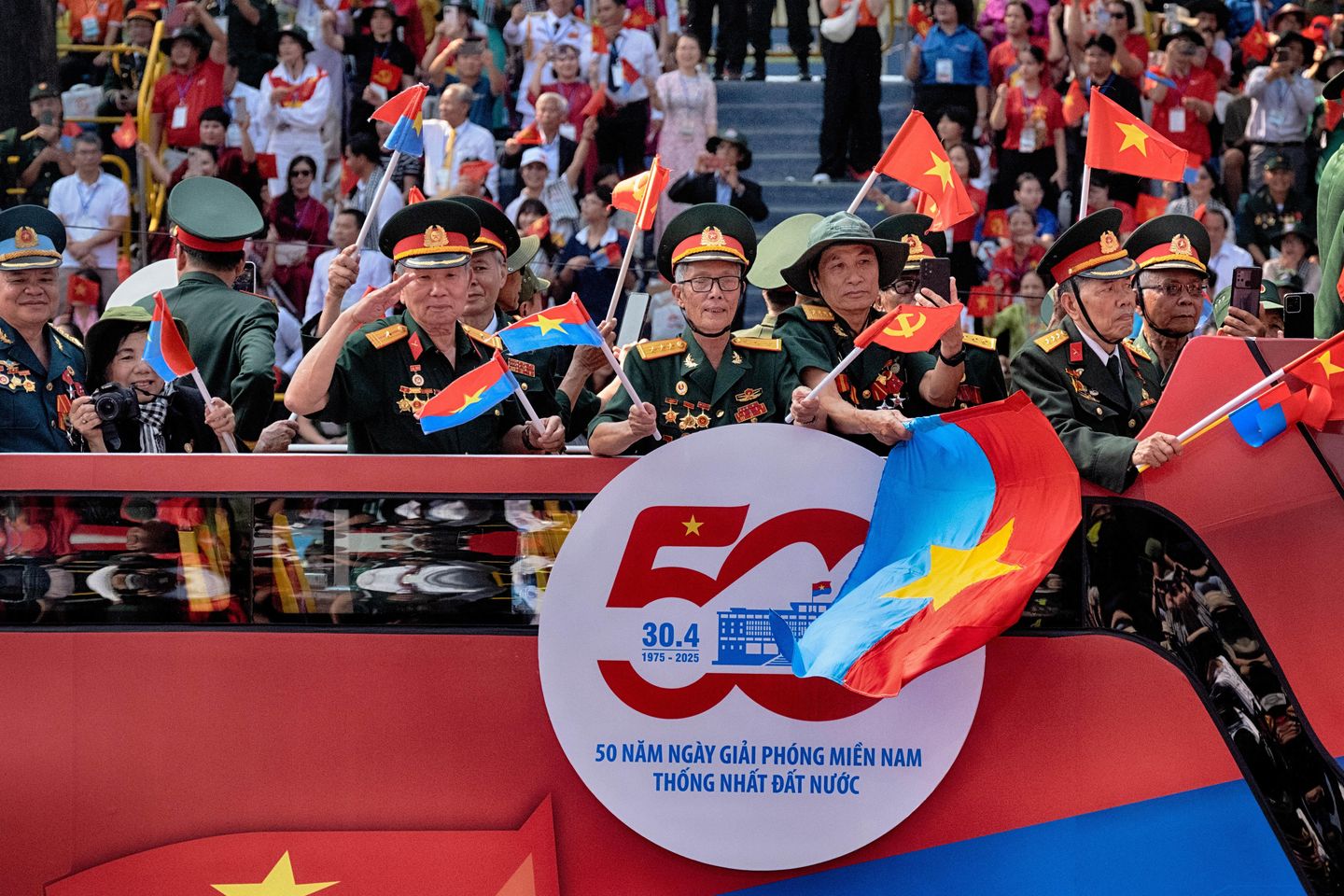
SEOUL, South Korea — Vietnam marked the 50th anniversary of national unification Wednesday with a flyover of jets and a parade featuring a portrait of independence leader Ho Chi Minh on a giant lotus leaf through the city named after him.
Thousands lined the parade route, waving red flags and singing patriotic songs as they celebrated the capture of South Vietnam’s capital, Saigon (renamed Ho Chi Minh City), by North Vietnamese forces on April 30, 1975. The outcome was the unified communist state of Vietnam, with its capital in Hanoi.
One informed visitor was struck by the profusion of flags of the National Liberation Front — the Viet Cong, or southern communist guerrillas — given that Saigon fell to North Vietnamese regular troops.
“That tells me Hanoi has a message of unity, they are trying to keep the south from feeling left out or restive,” said Don Kirk, an 86-year-old American reporter who covered the war from 1966 to 1973 and an invited guest of Vietnam’s Press Bureau. “In the south, they don’t feel terribly dominated and they can make money, but they can’t speak out against the regime.”
The victory of the communist North over the democratic South was a profound disaster not just for 1.2 million refugees who fled Vietnam, but also for U.S. prestige.
The war America could not win
U.S. troops had fought Asian communist forces with fair success a decade earlier: South Korea survived as a state.
GIs fought for South Vietnam from 1965 to 1973, suffering 58,000 dead — making it America’s bloodiest conflict since World War II.
Yet despite building massive bases and deploying colossal firepower, Washington failed to break the will of the North Vietnamese and Viet Cong. Instead, will on the U.S. homefront cracked as television media beamed the war into living rooms.
Some footage was glamorous: jungle patrols, helicopter assaults and airstrikes scored by rock ‘n’ roll.
But much imagery was disturbing: flaming villages, children scorched by napalm, South Vietnamese executing prisoners.
“I think U.S. media did contribute to feeling against the war, by acting as if we were screwing up all the time, and reporting the futility of what we were doing,” Mr. Kirk said by telephone from Vietnam, which he covered for the Chicago Tribune and other outlets. “Big media were basically antiwar: They were interested in showing how stupid we were.”
This factor, combined with Saigon’s corruption, a surprise communist offensive in 1968 and revelations of a massacre in My Lai by U.S. troops, prompted many Americans to turn against the war.
Washington’s stance was painted by some as imperialist; campuses were rocked by protests, and veterans were abused.
“For the first time in history, the Yanks were definitely the bad boys,” said Gastone Breccia, a military historian at the University of Pavia. “They were incapable of conquering a small, defiant people.”
Some point to U.S. leadership failures.
“In Vietnam, if [Army Gen. Dwight D.] Eisenhower had been president, the war would have lasted about a year,” said former U.S. House speaker Newt Gingrich during a recent trip to the region. “He understood winning.”
Though U.S. forces were largely undefeated, they were outmaneuvered as North Vietnamese massed in neighboring Laos and Cambodia.
GIs withdrew in 1973, the year that the draft also ended.
By 1975, as North Vietnam advanced, there was no appetite in Washington for an intervention. While the U.S. Navy rescued evacuees, Saigon’s forces fought their final battles alone.
Multiple legacies for multiple players
Since Vietnam, professionalized U.S. forces have prevailed in short conflicts (Grenada, Panama, the Persian Gulf War) but not in sustained battle zones (Somalia, Iraq, Afghanistan).
For Vietnam, the end of the fighting did not mean the end of war. In 1978, it invaded Cambodia, ejecting the murderous Khmer Rouge and occupying the country until 1989.
In 1979, China — which had aided North Vietnam and supported the Khmer Rouge — invaded Vietnam, sparking a two-month border war. Chinese troops, lacking Vietnamese combat expertise, were badly bloodied.
China and Vietnam last exchanged fire in 1988 in the South China Sea, where territorial disputes over reefs and shoals still simmer.
A core lesson of Vietnam — that a technologically advanced army may fail against determined peasant adversaries — was ignored by one of Hanoi’s key communist backers.
“Four-and-a-half years after the liberation — or fall — of Saigon, Moscow’s communists would have acquired their own Vietnam by invading Afghanistan,” Mr. Breccia said.
U.S. military leadership refocused on big war.
“That paid off in Desert Storm,” said David Maxwell, a retired Special Forces colonel. But in what he called an “ironic legacy,” it forgot Vietnam’s lessons when battling insurgents in Iraq and Afghanistan.
“Most of the military, except Special Forces and the U.S. Army JFK Special Warfare School, purged most of the doctrine in counterinsurgency because the military believed it would never conduct such a war as Vietnam again,” Mr. Maxwell said.
Some combatants such as Australia suffered similar trauma to America’s. But for South Korea, the U.S. ally that supplied the largest troop contingent in Vietnam, outcomes were nuanced.
Washington’s support for dictatorial Seoul regimes “postponed democracy for decades,” said Korean-American scholar Tae-yang Kwak, whose Harvard doctoral thesis explored the issue.
But there were economic upsides.
“Over 300,000 South Korean soldiers fought, and around 100,000 civilian contractors labored in South Vietnam over the course of the war,” leading to an “economic boom” for South Korea “and also for hundreds of thousands of families lifted into the middle class by salary remissions,” Mr. Kwak said.
A resilient people
Today, Hanoi has rebuilt relations with Washington and Beijing. Though communist, Vietnam has, like China, unleashed controlled capitalism across its economy.
Integrated into global supply chains, it benefits from overspill from China’s huge manufacturing sector, and investment from countries including South Korea.
It is frequently visited by Western warships; Western arms firms view Vietnam as a promising market.
Tourists from across the world visit its attractions, including war sites Hoa Lo Prison — ironically dubbed the Hanoi Hilton by U.S. captives — and (widened) Viet Cong tunnels at Cu Chi, near Ho Chi Minh City.
For Mr. Kirk, who had just visited Cu Chi, Vietnam’s resilience stood out.
“There is no doubt that life’s a heck of a lot better now, it’s amazing how Vietnam has recovered,” he said. “How and why did we spend so much time here — and what could we have done differently to have ended mass suffering on all sides?”












